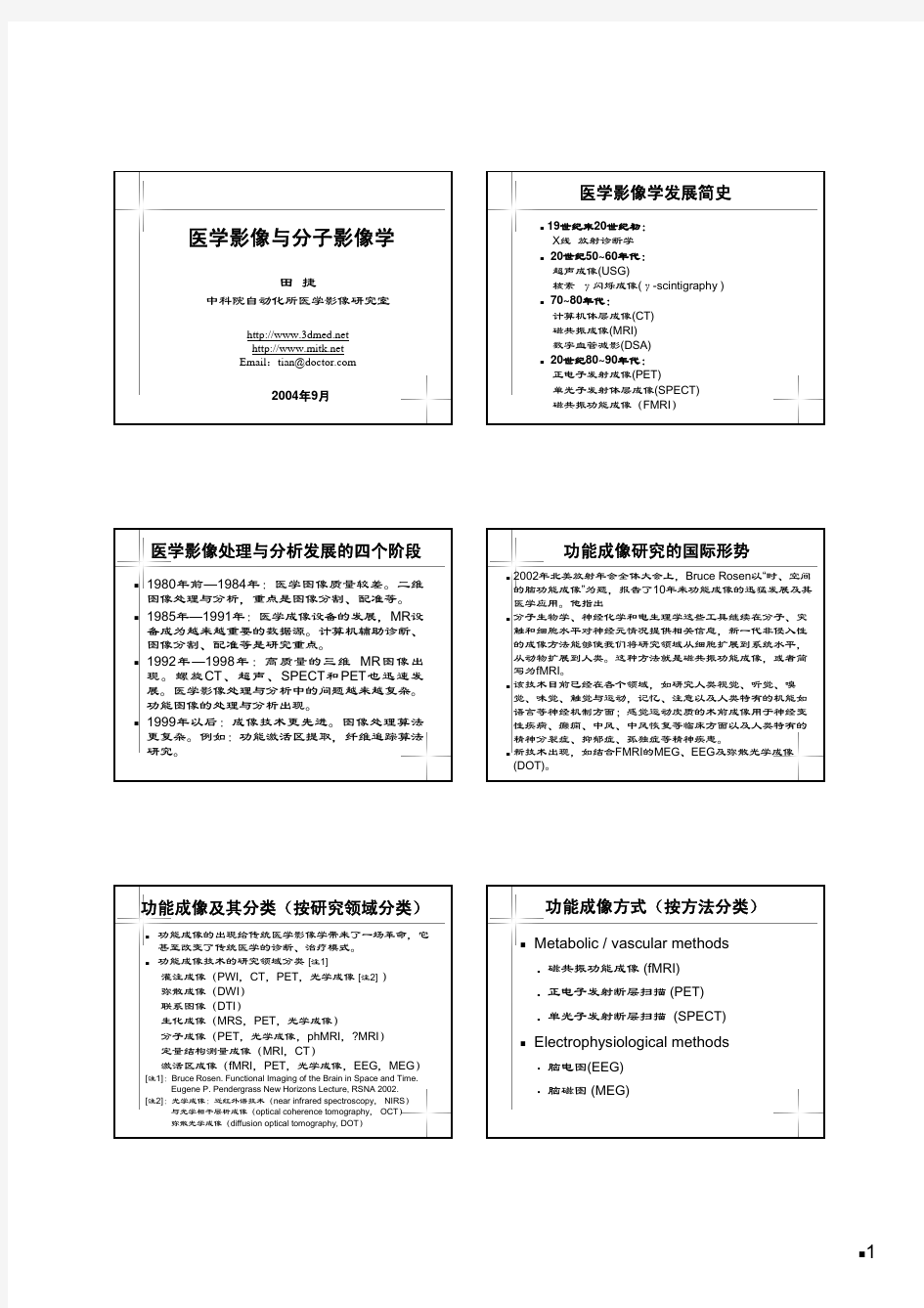

静息态功能核磁共振技术发展及其应用 一、什么是静息态功能核磁共振技术 (一)、功能磁共振技术及其原理 人脑是自然界进化最为复杂的产物,揭示脑的奥秘是当代自然科学面临的最重大的挑战之一。近年来随着脑成像技术及神经科学的发展,人们对脑的研究已不仅局限于解剖定位,更多的是对脑功能活动基本过程的深入研究。功能磁共振成像是90年代以后发展起来的一项新技术,它结合了功能、影像和解剖三方面的因素,是一种在活体人脑中定位各功能区的有效方法,它具有诸多优势,如无创伤性、无放射性、具有较高的时间和空间分辨率、可多次重复操作等,因此,功能磁共振成像(functional magnetic resonance imaging,fMRI )作为脑功能成像的首选方法已被较广泛应用。功能磁共振成像主要是基于血流的敏感性和血氧水平依赖性(blood oxygenation level dependent,BOLD )对比度增强原理进行成像。所谓血氧水平依赖性是指大脑皮层的微血管中的血氧浓度发生变化时,会引起局部磁场发生变化,从而引起核磁共振信号强度的变化。采用基于 BOLD的功能磁共振成像技术进行脑活动研究在近十年中得到了迅速的发展,BOLD f MRI以空间和时间分辨率均较高的优势,逐渐成为对活体脑功能生理、病理活动研究的重要手段之一。其无创性和可重复性使之在临床得以迅速而广泛的应用和认同功能磁共振检查方法对人体无福射损伤,并且其时间及空间分辨率较高,一次成像可同时获得解剖影像及功能影像。功能磁共振成像原理是通过磁共振信号检测顿脑内血氧饱和度及血流量,从而间接反映神经元的活动情况,达到功能成像的目的。BOLD 技术是功能磁共振成像的基础;神经元活动增强时,脑功能区皮层的血流量和氧交换増加,但与代谢耗氧量增加不成比例,超过细胞代谢所需的氧供应量,其结果可导致功能活动区血管活动氧合血红蛋白増高,脱氧血红蛋白相对减少。脱氧血红蛋白是顺磁性物质,其铁离子有4个不成对电子,磁矩较大,有明显的T2缩短效应。因此,脱氧血红蛋白减少,导致T2*和T2弛豫时间延长,信号増高,使脑功能成像时功能活动去抑制的皮层表现为高信号。功能磁共振成像应用于人脑功能的研究,最常用的方法是利用各种刺激诱导局部脑组织血氧水平依赖信号发生变化,间接反映神经元的活动,这种方法被称为“事件相关功能性磁共振( event-related f MRI)”。
Different Neural Manifestations of Two Slow Frequency Bands in Resting Functional Magnetic Resonance Imaging: A Systemic Survey at Regional,Interregional, and Network Levels Shao-Wei Xue,1,2Da Li,1,2Xu-Chu Weng,1,2Georg Northoff,1,3 and Dian-Wen Li 1,2 Abstract Temporal and spectral perspectives are two fundamental facets in deciphering ?uctuating signals.In resting state, the dynamics of blood oxygen level-dependent (BOLD)signals recorded by functional magnetic resonance im-aging (fMRI)have been proven to be strikingly informative (0.01–0.1Hz).The distinction between slow-4(0.027–0.073Hz)and slow-5(0.01–0.027Hz)has been described,but the pertinent data have never been system-atically investigated.This study used fMRI to measure spontaneous brain activity and to explore the different spectral characteristics of slow-4and slow-5at regional,interregional,and network levels,respectively assessed by regional homogeneity (ReHo)and mean amplitude of low-frequency ?uctuation (mALFF),functional con-nectivity (FC)patterns,and graph theory.Results of paired t -tests supported/replicated recent research dividing low-frequency BOLD ?uctuation into slow-4and slow-5for ReHo and mALFF.Interregional analyses showed that for brain regions reaching statistical signi?cance,FC strengths at slow-4were always weaker than those at https://www.doczj.com/doc/607518963.html,munity detection algorithm was applied to FC data and unveiled two modules sensitive to frequency effects:one comprised sensorimotor structure,and the other encompassed limbic/paralimbic system.Graph the-oretical analysis veri?ed that slow-4and slow-5differed in local segregation measures.Although the manifes-tation of frequency differences seemed complicated,the associated brain regions can be grossly categorized into limbic/paralimbic,midline,and sensorimotor systems.Our results suggest that future resting fMRI research addressing the three above systems either from neuropsychiatric or psychological perspectives may consider using spectrum-speci?c analytical strategies. Key words:community detection;functional connectivity;functional magnetic resonance imaging;graph theory; mean amplitude of lower frequency ?uctuation;regional homogeneity Introduction T he human brain is a large and complex network or-ganized by spatial,temporal,and spectral principles.In active mental operation,frequency effects are task sensitive in a topographical manner.For example,electroencepha-lography (EEG)studies reveal that short-term memory pro-cesses are re?ected by theta oscillation in the anterior limbic system,whereas long-term memory processes are re?ected by upper alpha oscillations in the posterior thalamic system (Klimesch,1996).Synchronization in gamma spec-trum can enable object representation and contribute to the maintenance of information in memory (Bertrand and Tallon-Baudry,2000).In resting state,neural characteristics also confer physiological and neuropsychological signi?cance.Neuronal oscillation provides supporting context for various functions,including input selection,plasticity,perceptual binding,psychological representation,and learning (Buzsaki and Draguhn,2004).Frontal alpha asymmetry has long been regarded as a potential indicator of temperament and affec-tive reactivity (Davidson,1992;Hagemann et al.,1998),and connectivity strengths over several brain regions may have implications in depressive disorder (Fingelkurts et al.,2007;Lee et al.,2011a). 1Center for Cognition and Brain Disorders,Hangzhou Normal University,Hangzhou,China. 2 Zhejiang Key Laboratory for Research in Assessment of Cognitive Impairments,Hangzhou,China.3 Mind,Brain Imaging and Neuroethics,Institute of Mental Health Research,University of Ottawa,Ontario,Canada. BRAIN CONNECTIVITY Volume 4,Number 4,2014aMary Ann Liebert,Inc. DOI:10.1089/brain.2013.0182 242